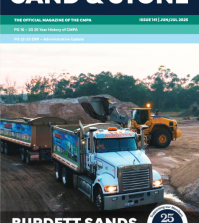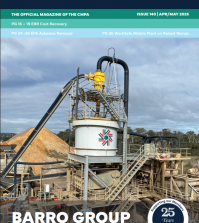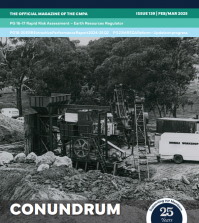Transforming a Piece of Victorian History
BRUCE EDWARDS, General Manager Marketing for William Adams reports on the transformation of Cave Hill Quarry.
In a ground-breaking new project, Cave Hill Quarry, Lilydale will be transformed into one of the most spectacular development opportunities ever to be seen in Melbourne. The Kinley vision is set to become Melbourne’s newest eastern suburb, encapsulating a series of well-connected neighbourhoods – including a village centre with specialty shops, cafes and public spaces. Every home will enjoy easy access to leafy streets, green parkland and a network of walking and cycling trails.

Looking back at where it all began
Established in 1878 by prominent businessman and father of Dame Nellie Melba, David Mitchell, the Cave Hill Quarry site was one of the primary sources of limestone in Victoria. The site consisted of a quarry pit, limestone processing area and farmland, including dairy and bacon factories and the silage store. David Mitchell was known for being innovative and entrepreneurial and as such, the heritage listed tunnel within the quarry is believed to be the most extensive battery of pot kilns in Victoria and also home to one of the earliest continuous mixed-feed
vertical shaft kilns in Australia.
In addition to the Cave Hill site, David Mitchell also built many of Melbourne’s landmark buildings including the World-Heritage listed Royal Exhibition Building. With a rich and vibrant history, there is no doubt that the Mitchell family was prominent in shaping Melbourne’s early history and culture.
The Mitchell family sold the quarry in 2002, and in 2015 the quarry ceased operations entirely. The site was purchased by a consortium that is undertaking the joint venture redevelopment and the Kinley vision was born. Bayport is part of the joint venture development and the company’s Managing Director, Richard Torossi, explained that, “In keeping with the history of the site, the redevelopment will endeavour to restore and revive the site’s heritage.”
From the ground up
The size of the project is enormous – the largest single urban-infill site in Australia. The quarry itself is large enough to house the Melbourne Cricket Ground and that alone makes up less than one-sixth the development area.
The scope and size of the redevelopment is certainly not a small undertaking and filling the 125-metre-deep, 9-million cubic-metre hole is not without challenges. Water seepage at the bottom of the quarry is significant and requires a heavy-duty pump to operate 24 hours a day, seven days a week, pumping 1.8 million litres of ground water per day.
The engineering methodology for filling the hole involves placing the material in certain layers combined with detailed geotechnical testing, to make sure each layer is compacted and able to provide a strong foundation for future housing and facilities. The hole will be filled with native overburden material and the filling process is expected to take approximately seven years.

Bring in the big trucks
The quarry is a flurry of activity, with big yellow trucks transporting what is likely to total 400,000 truckloads, carrying 20 million tonnes of fill over the course of the next seven years. Caterpillar was selected as the best choice for this demanding application due to their superior performance and technology driven equipment management. In fact, Bayport has enjoyed a longstanding relationship with local Caterpillar dealer, William Adams in Victoria.
Richard explained that this relationship with Caterpillar started back in the late 1960’s with his father, Mario, and uncle, Wally. “William Adams has always provided the right equipment for the specific task at hand. There are about 30 pieces of predominantly Cat equipment on the Cave Hill site alone including seven large Cat 773 50 tonne dump trucks carrying material from the top through to the bottom of the quarry.”

The largest of all machines onsite is the Caterpillar 390F L Hydraulic Excavator. One of two 390’s on site, this machine helps to keep production numbers up and reduces owning and operating costs while providing all the power, fuel efficiency, and reliability to maximise productivity. Used in conjunction with the new fuel-efficient Cat 773 G trucks, haul material can be loaded at a lower cost per tonne.
The latest addition to the Cat fleet at Cave Hill is the D8T Dozer. The D8T joins the latest Cat 982M Series Wheel Loader, two 825K Compactors, and two Cat 19 tonne vibratory rollers – a CP76 padfoot and a smooth drum CS78 are also used at the site to provide superior compaction as each layer of the quarry is filled to a specified density. These compactors have a GPS record for ease of operation, helping operators to distinguish between areas that have been compacted and those that still require attention.
“The reliability and performance of the Caterpillar equipment makes it the perfect choice to successfully transform this site from a once proud industrial site to a new and exciting residential development,” said Richard.
A new lease on life
It would be hard to find a site that comes close to Cave Hill’s rich 140-year history. Throughout its lifetime, it has provided limestone for landmark Victorian infrastructure projects, farming products for government and households alike and was also home to one of Australia’s most famous opera singers.
As the site now enters another new and exciting era, its past will not be forgotten but preserved, respected and celebrated. Once complete, the 163-hectare site will be home to thousands of Victorians with a 4000-lot subdivision, commercial centres, retail, cafes and a proposed train station. Once again, life will go on at Cave Hill as the Kinley era begins.














You must be logged in to post a comment Login